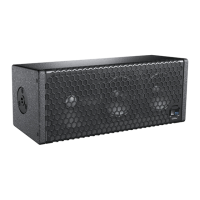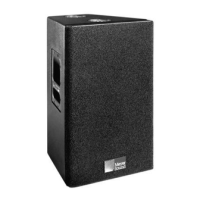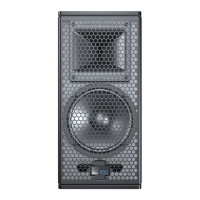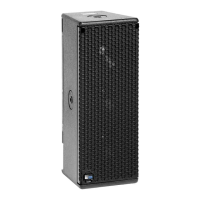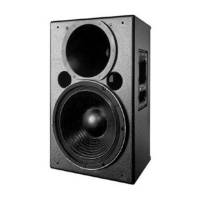23
CHAPTER 4: ADDING LOW FREQUENCY CONTROL
A UPQ-D Series loudspeaker system can be deployed with
Meyer Sound self-powered low frequency control elements
(see Table 3). These subwoofers achieve very low frequency
responses and extend the system response appreciably,
increasing the overall acoustic power of the system in the
lowest frequencies.
The ideal ratio of UPQ-D Series loudspeakers to low
frequency control element depends on the following
variables:
• Subwoofer model
• System configuration
• Frequency content of the source material
• Headroom required for low frequencies
For most applications, the ratios in Table 3 should yield
good results.
ADDING SUBWOOFERS BY DAISY-CHAINING
Full-range signals can be connected directly to
Meyer Sound self-powered loudspeakers, because the
loudspeakers have built-in active crossovers. Subwoofers
can be added to a UPQ-D Series system by simply
daisy-chaining them to the UPQ-D Series loudspeakers.
To daisy-chain the suggested number of UPQ-D Series
loudspeakers for the selected subwoofer (see Table 1):
1. Connect the source signal to the Input of the first
UPQ-D Series loudspeaker, then connect the Loop
output of the first loudspeaker to the Input of the second
loudspeaker and so forth.
2. Connect the Loop output of the last UPQ-D Series
loudspeaker in the chain to the subwoofer Input.
When UPQ-D Series loudspeakers are coplanar, or they are
very close together (about four to six feet like in the case of
pole mounting), the phase response will work well in the
area of interaction and the result will be a fairly flat
frequency response. However, the response will show an
increase in the 60–200 Hz range where the response of the
loudspeakers overlaps.
NOTE: If the subwoofer’s Limit LEDs begin to
light before reaching the required SPL, con-
sider adding more subwoofers to meet the SPL
requirements without exposing the drivers to exces-
sive heat and excursion.
USING A PROCESSOR
In larger systems when individual control for the
UPQ-D Series loudspeakers and subwoofers are needed or
desired, if the UPQ-D Series loudspeakers and subwoofer
are more than six feet apart, or if a delay is required between
them, use a measurement system like Meyer Sound’s SIM
to determine appropriate delay and polarity settings.
CAUTION: Make sure the source signal is
sufficient to drive the total load impedance of
the daisy-chained loudspeakers (see “Calculating
Load Impedance for Looped Audio Signals” on
page 20).
TIP: MAPP can be used to accurately predict
the appropriate loudspeaker deployment and
subwoofer integration for loudspeaker systems,
complete with coverage data, system delay and
equalization settings, rigging information, and
detailed design illustrations. For more information,
see “MAPP System Design Tool” on page 33.
Ta b l e 3: R ec o mm en d e d Meyer Sound Subwoofer
Subwoofer Frequency
Response
Recommended Ratio
(Number of UPQ-D Series per
Subwoofer)
USW-210P 32–123 Hz ±4 dB 1:1 for most applications
1:2 for applications requiring
more low end
750-LFC 37–110 Hz ±4 dB 1:1 for most applications
900-LFC 32–115 Hz ±4 dB 2:1 for most applications
1:1 for applications requiring
extreme low end
1100-LFC 30–85 Hz ±4 dB 4:1 for most applications
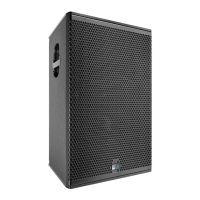
